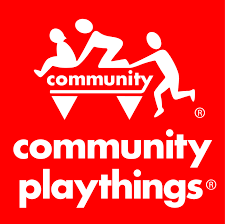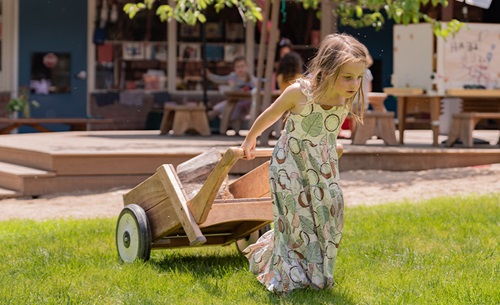Developing Executive Function in Young Children
How understanding neuroscience helps educators nurture executive function.
| August 2025The early years of a child’s life are nothing short of amazing. During this time, the brain is growing at a rate faster than it will ever again, forming more than a million new connections every second. By age five, a child’s brain is already 90% developed. But early childhood isn’t just about learning the ABCs or how to tie shoes; it’s about laying the foundation for how children will learn, connect with others, and manage emotions for the rest of their lives.
As educators and program leaders, understanding what’s happening inside the brain during this period is not a luxury; it’s a necessity. Groundbreaking insights from neuroscience provide us with tools and strategies to better support children’s development, particularly in the area of executive function—the brain’s self-management system that enables us to plan, focus, remember instructions, regulate emotions, and adapt to change.
To nurture executive function in young children, we must first understand three powerful brain processes that drive its development: neurogenesis, neuroplasticity, and synaptic pruning.
What Is Executive Function, and Why Does It Matter?
Executive function is often compared to an air traffic control system. Just as air traffic controllers manage the safe and orderly flow of airplanes, the executive function system in the brain manages impulses, attention, emotions, and decision-making. A strong executive function system allows children to take turns, resist distractions, remember rules, solve problems, and recover from setbacks.
When executive function skills are still developing, young children may struggle to wait their turn, follow multi-step directions, manage frustration, or collaborate with peers. These challenges often appear as what we label “misbehavior,” but more often than not, they are signs of missing skills, not defiance.
The good news? Executive function skills can be taught, practiced, and strengthened—especially when we understand how the brain builds these capacities.
Neurogenesis: Building the Brain’s Foundation
Neurogenesis is the birth of new neurons—the brain cells that send signals throughout the nervous system. This process is especially rapid in early childhood, particularly in brain areas responsible for learning, memory, and emotional regulation.
Each new experience, from hearing a story to climbing on a jungle gym, helps determine whether these new neurons survive and integrate into the brain’s networks. Positive, stimulating environments provide the rich input needed for healthy neurogenesis.
What Educators Can Do:
- Foster curiosity through play-based, child-led learning experiences.
- Offer diverse sensory experiences such as music, movement, tactile play, and outdoor exploration.
- Encourage language development through talking, singing, and reading aloud.
- Build secure relationships where children feel safe, seen, and supported.
When educators nurture exploration and emotional safety, they help ensure that new brain cells grow and become part of the brain’s working structure.
Neuroplasticity: Shaping the Brain Through Experience
Neuroplasticity refers to the brain’s ability to change, adapt, and grow in response to experiences. This is the brain’s superpower. Every time a child solves a problem, calms down after getting upset, or waits patiently in line, their brain rewires itself to be more efficient at managing those same tasks in the future.
Plasticity is greatest in early childhood, making this the optimal time for developing strong mental habits and skills. But neuroplasticity is a double-edged sword: while positive experiences build strong, healthy pathways, repeated negative experiences (like trauma or unpredictable care) can strengthen stress-driven brain patterns.
What Educators Can Do:
- Model calm behavior and self-regulation strategies.
- Celebrate effort and persistence to promote a growth mindset.
- Provide frequent practice of executive function skills through games and routines.
- Co-regulate emotions, helping children navigate stress until they can do so independently.
Every repetition matters. Repeated exposure to positive, structured interactions strengthens the brain’s “muscles” for executive function.
Synaptic Pruning: Fine-Tuning the Brain’s Wiring
In early childhood, the brain produces an excess of synapses—the connections between neurons. Then, through a process known as synaptic pruning, it eliminates the ones that aren’t used regularly. This “use it or lose it” principle makes the brain more efficient, keeping only the pathways that are needed and strengthening them through repetition.
Pruning helps children’s brains work more efficiently, respond more effectively to challenges, and lay the foundation for complex thinking. However, if a child has limited access to enriching experiences, the brain may prune away connections needed for essential cognitive, social, or emotional functions.
What Educators Can Do:
- Repeat important routines daily to reinforce memory and planning.
- Use visual schedules and cue cards to help children anticipate and organize tasks.
- Engage in guided play that challenges children to think flexibly, recall steps, and control impulses.
- Introduce calming and focusing strategies like deep breathing, music, or mindfulness.
The key to healthy pruning is consistency. Each time a child uses a skill, such as transitioning between activities or resolving a peer conflict, they are signaling to the brain: “Keep this connection. I need it.”
The Classroom as a Brain-Building Environment
To maximize these three brain processes, classrooms must be intentionally designed to support both learning and emotional safety. The most effective environments offer structure, warmth, and opportunities for children to take risks, make mistakes, and try again.
Relationships Matter
Children learn best when they feel safe, secure, and connected to their caregivers. Educators who build strong, trusting relationships with their students help calm the brain’s stress response, opening the door to learning.
Behavior Is Communication
Challenging behaviors are often signs of underdeveloped executive function skills. By shifting from a mindset of “discipline” to “skill-building,” we become co-regulators and coaches rather than enforcers.
Embed Executive Function Practice
Integrate executive function into everyday routines like lining up, choosing centers, cleaning up, and problem-solving during play. Every moment can be a chance to build attention, memory, and self-control.
Common Misconceptions and Mindset Shifts
Understanding neuroscience helps educators shed outdated beliefs. For example:
-
Myth: Some children are just “bad kids” or “can’t sit still.”
- Neuroscience truth: Many challenging behaviors stem from immature brain development, not willful disobedience.
-
Myth: Executive function is something children either have or don’t.
- Neuroscience truth: Executive function skills are developmental and can be taught, practiced, and improved.
By viewing behavior through a brain-based lens, educators can shift from frustration to curiosity, from reacting to understanding.
Why Adult Executive Function Matters Too
Just as children need strong executive function skills to succeed, so do the adults who care for them. An educator’s ability to stay calm, organized, and emotionally present directly impacts the classroom climate and children’s learning.
Modeling is powerful. When teachers practice mindfulness, regulate their tone, use consistent routines, and demonstrate flexible thinking, they are actively shaping the executive function systems of the children around them.
Investing in educators’ well-being, training, and self-awareness is not a side note—it’s central to creating brain-friendly classrooms.
Final Thoughts: You Are a Brain Changer!
Neuroscience tells us that early childhood educators are not just caretakers or curriculum deliverers. You are brain changers. Every word of encouragement, every practice of patience, every game that stretches memory or focus, every nurturing moment—it all counts.
By understanding and leveraging neurogenesis, neuroplasticity, and synaptic pruning, you can help children build the strong executive function skills they need not only for school readiness but for lifelong resilience, empathy, and success.
When we teach with the brain in mind, we do more than impart knowledge—we shape minds that are curious, capable, and kind.
References and Further Reading
CASEL (Collaborative for Academic, Social, and Emotional Learning). n.d. The CASEL Framework. Accessed 2025. https://casel.org.
Center on the Developing Child at Harvard University. n.d. Center on the Developing Child at Harvard University. Accessed 2025. https://developingchild.harvard.edu.
Epstein, Ann S. 2014. Essentials of Active Learning in Preschool. 2nd ed. Ypsilanti, MI: HighScope Press.
Reflection Sciences, Inc. n.d. Reflection Sciences. Accessed 2025. https://www.reflectionsciences.com.












